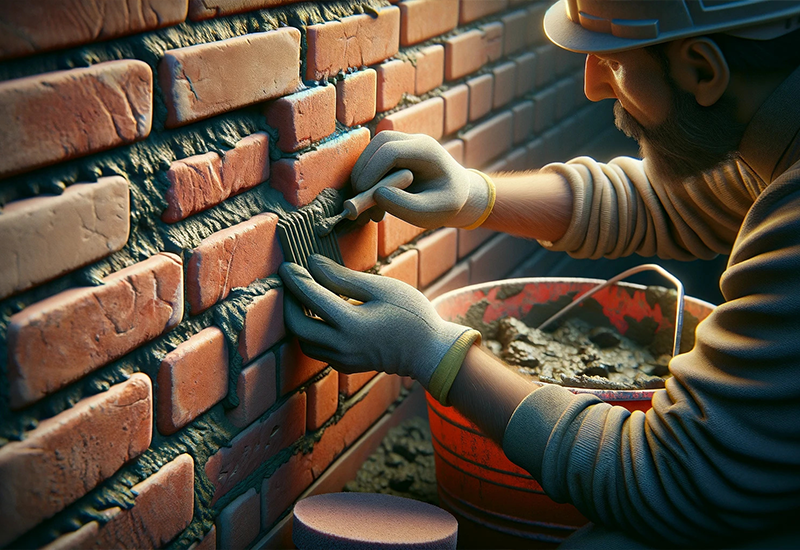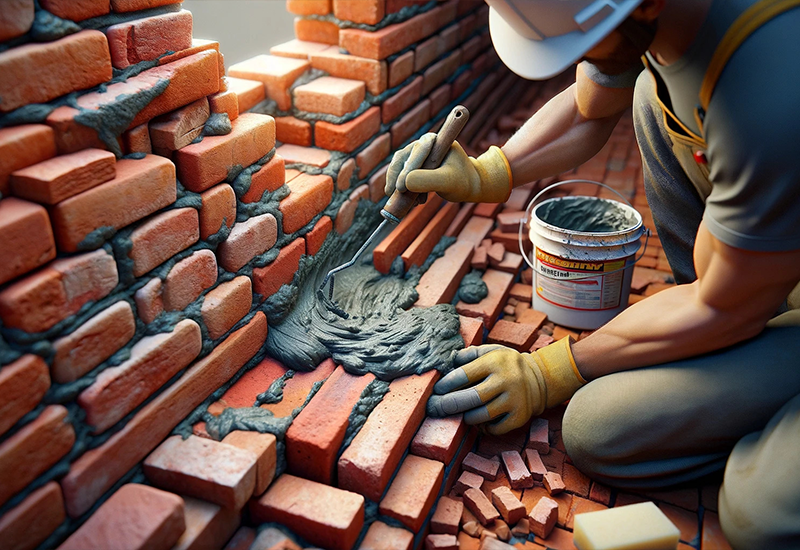
Brick grout repair is a crucial aspect of maintaining the integrity and appearance of brick structures. Whether it’s a historic building or a modern residence, the stability and longevity of brickwork largely depend on the condition of the grout. Timely repair and maintenance can prevent structural damage and preserve the aesthetic value of the brick construction. This article delves into the importance, methods, and tips for effective brick grout repair, catering to homeowners and DIY enthusiasts alike.
Table of Contents
Understanding Brick Grout and Its Importance
Brick grout, vital in masonry, holds bricks together, ensuring structural integrity and aesthetic appeal. It’s susceptible to damage from environmental factors, necessitating regular inspection and maintenance.
Definition and Role of Grout in Brickwork
Brick grout, a fundamental component in masonry, is a form of mortar that fills the gaps between bricks, bonding them together to form a sturdy and cohesive structure. It plays a critical role in the integrity and longevity of brickwork, acting as a sealant that prevents moisture and other elements from penetrating and weakening the structure. Grout is made from a mixture of water, cement, and sand, which, when applied correctly, forms a strong, hard bond between the bricks.
Signs of Grout Damage
Recognizing the signs of grout damage is key to timely repairs. Common indicators include cracking, crumbling, or missing grout. Over time, exposure to the elements, physical impact, or natural settling of the structure can lead to these issues. In some cases, you might notice water seepage or dampness on the interior walls, which is often a result of failing grout in the exterior brickwork.
The Consequences of Neglected Brick Grout
Ignoring damaged grout can lead to severe structural problems and safety hazards. Crumbling grout weakens brick structures, causing instability, and water infiltration. Aesthetically, it detracts from the building’s appearance, impacting its overall value.
Structural Implications
Neglecting damaged grout can lead to severe structural issues. When grout deteriorates, it loses its ability to hold the bricks together securely, which can compromise the wall’s stability. In extreme cases, this can lead to partial or complete collapse of the brickwork, posing a significant safety hazard.
Aesthetic Impact
Apart from structural implications, damaged grout adversely affects the aesthetic appeal of the brick structure. Cracked or missing grout can make even the most well-designed buildings look unkempt and neglected. This can be particularly problematic for historical buildings where maintaining the original appearance is crucial.
Preparation for Brick Grout Repair
Effective brick grout repair begins with proper preparation. Gather essential tools like chisels, hammers, grout saws, and safety gear. Understand the repair process, and prepare the area by cleaning out old, damaged grout thoroughly.
Tools and Materials Needed
To prepare for brick grout repair, you will need several tools and materials. These include:
- Chisel and hammer for removing old grout.
- Grout saw or angle grinder for tougher grout.
- Safety glasses and gloves for protection.
- Dust mask to avoid inhaling fine particles.
- Bucket and mixing tool for preparing new grout.
- Grout bag or trowel for applying the grout.
- Sponge and water for cleanup.
Safety Considerations
Safety is paramount when undertaking grout repair. Wear protective eyewear to guard against flying debris, gloves to protect your hands, and a dust mask to prevent inhalation of harmful particles. Ensure the work area is well-ventilated, especially when working with dry grout mix, which can be hazardous when inhaled.
Step-by-Step Guide to Brick Grout Repair

Brick grout repair involves several key steps: removing old grout, preparing and mixing new grout, and applying it carefully. Each step requires attention to detail to ensure a durable and visually appealing finish.
Removing Old Grout
- Identify the damaged grout areas.
- Use a chisel and hammer or a grout saw to carefully remove the old grout. Be cautious not to damage the bricks.
- Clean out the joints thoroughly to prepare them for new grout.
Mixing and Applying New Grout
- Mix the grout according to the manufacturer’s instructions to achieve the right consistency.
- Use a grout bag or trowel to apply the grout into the joints.
- Press the grout firmly to ensure there are no air pockets.
Finishing Touches
- Smooth out the grout lines with a jointing tool or a small piece of wood.
- Wipe away excess grout from the brick faces with a damp sponge.
- Allow the grout to cure as per the recommended time.
Conclusion
In conclusion, brick grout repair is not just about maintaining the physical appearance of a structure but also about ensuring its strength and durability. Regular inspection, understanding the right techniques, and using suitable materials are key to effective grout repair. Whether you choose to do it yourself or hire professionals, remember that taking care of the grout is an investment in the longevity and safety of your brick structures.
FAQs
Q: What Is Brick Grout Repair and Why Is It Important?
A: Brick grout repair involves fixing the mortar that holds bricks together. It’s crucial for maintaining structural integrity, preventing moisture penetration, and preserving the aesthetic appeal of brick structures.
Q: How Often Should Brick Grout Repair Be Done?
A: The frequency of brick grout repair depends on the structure’s age and environmental exposure. Generally, a thorough inspection every few years is advisable to assess and address any grout deterioration.
Q: Can I Perform Brick Grout Repair Myself, or Should I Hire a Professional?
A: DIY brick grout repair is possible for minor issues, but it requires some skill and the right tools. For extensive damage, hiring a professional ensures the job is done correctly and safely.
Q: What Are the Common Signs That Brick Grout Needs Repair?
A: Indicators include crumbling or cracking grout, loose bricks, and moisture issues inside the building. Regular checks can help catch these signs early.
Q: What Are the Best Practices for Long-Lasting Brick Grout Repair?
A: Using the correct grout mix, ensuring proper application, and regular maintenance are key. Additionally, choosing materials compatible with your bricks can prolong the repair’s life.


